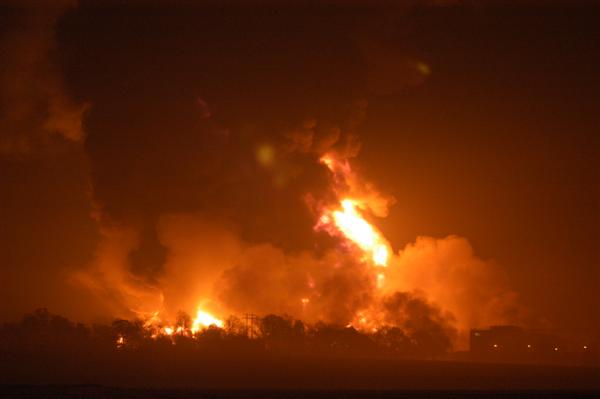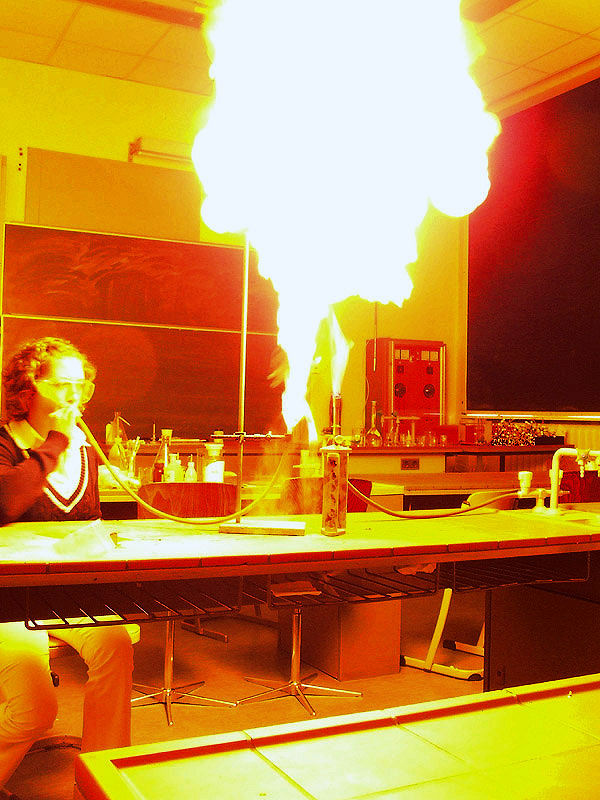|
Thermobaric Weapon
A thermobaric weapon, also called an aerosol bomb, a vacuum bomb or a fuel air explosive (FAE), is a type of explosive that uses oxygen from the surrounding air to generate a high-temperature explosion. The fuel–air explosive is one of the best-known types of thermobaric weapons. Thermobaric weapons are almost 100% fuel and as a result are significantly more energetic than conventional explosives of equal weight. Many types of thermobaric weapons can be fitted to hand-held launchers, and can also be launched from airplanes. The largest Russian bomb contains a charge of approximately 7 tons of a liquid fuel that when detonated creates an explosion of 39.9 tons TNT equivalent. Terminology The term ''thermobaric'' is derived from the Greek words for 'heat' and 'pressure': ''thermobarikos'' (θερμοβαρικός), from ''thermos'' (θερμός) 'hot' + ''baros'' (βάρος) 'weight, pressure' + suffix ''-ikos'' (-ικός) '-ic'. Other terms used for the family of weapons ... [...More Info...] [...Related Items...] OR: [Wikipedia] [Google] [Baidu] |
USS McNulty (DDE-581) Sunk As Target With FAE 1972
USS ''McNulty'' (DE-581) was a ''Rudderow''-class destroyer escort in the United States Navy during World War II. Namesake John Thomas McNulty was born on 23 April 1897 at Philadelphia, Pennsylvania. He enlisted in the Navy on 14 August 1917 for World War I service, until discharged 7 August 1919. He reenlisted 15 July 1920 for the period to 10 July 1924, and after his third enlistment, 29 July 1924, served continuously until his death. Commissioned Ensign on 3 November 1941, he was promoted to Lieutenant (junior grade) on 15 June 1942. He was killed in action on the during the Battle of Savo Island on 9 August 1942. History ''McNulty'' was laid down 17 November 1943 by Bethlehem-Hingham Shipyard, Inc., Hingham, Massachusetts; launched 8 January 1944; sponsored by Mrs. Helen K. McNulty; and commissioned 31 March 1944. After shakedown off Bermuda, ''McNulty'' trained along the east coast until leaving Chesapeake Bay on escort duty with UGS‑46 to Bizerte, Tunisia. Her guns ... [...More Info...] [...Related Items...] OR: [Wikipedia] [Google] [Baidu] |
Bunker
A bunker is a defensive military fortification designed to protect people and valued materials from falling bombs, artillery, or other attacks. Bunkers are almost always underground, in contrast to blockhouses which are mostly above ground. They were used extensively in World War I, World War II, and the Cold War for weapons facilities, command and control centers, and storage facilities. Bunkers can also be used as protection from tornadoes. Trench bunkers are small concrete structures, partly dug into the ground. Many artillery installations, especially for coastal artillery, have historically been protected by extensive bunker systems. Typical industrial bunkers include mining sites, food storage areas, dumps for materials, data storage, and sometimes living quarters. When a house is purpose-built with a bunker, the normal location is a reinforced below-ground bathroom with fiber-reinforced plastic shells. Bunkers deflect the blast wave from nearby explosions to prevent ... [...More Info...] [...Related Items...] OR: [Wikipedia] [Google] [Baidu] |
Antipersonnel
An anti-personnel weapon is a weapon primarily used to maim or kill infantry and other personnel not behind armor, as opposed to attacking structures or vehicles, or hunting game. The development of defensive fortification and combat vehicles gave rise to weapons designed specifically to attack them, and thus a need to distinguish between those systems and ones intended to attack people. For instance, an anti-personnel landmine will explode into small and sharp splinters that tear flesh but have little effect on metal surfaces, while anti-tank mines have considerably different design, using much more explosive power to effect damage to armored fighting vehicles, or use explosively formed penetrators to punch through armor plating. Many modern weapons systems can be employed in different roles. For example, a tank's main gun can fire armor-piercing ammunition in the anti-tank role, high-explosive ammunition in the anti-structure role and fragmentation shells in the anti-personnel ... [...More Info...] [...Related Items...] OR: [Wikipedia] [Google] [Baidu] |
Atmospheric Oxygen
Atmospheric chemistry is a branch of atmospheric science in which the chemistry of the Earth's atmosphere and that of other planets is studied. It is a multidisciplinary approach of research and draws on environmental chemistry, physics, meteorology, computer modeling, oceanography, geology and volcanology and other disciplines. Research is increasingly connected with other areas of study such as climatology. The composition and chemistry of the Earth's atmosphere is of importance for several reasons, but primarily because of the interactions between the atmosphere and living organisms. The composition of the Earth's atmosphere changes as result of natural processes such as volcano emissions, lightning and bombardment by solar particles from corona. It has also been changed by human activity and some of these changes are harmful to human health, crops and ecosystems. Examples of problems which have been addressed by atmospheric chemistry include acid rain, ozone depletion, photoch ... [...More Info...] [...Related Items...] OR: [Wikipedia] [Google] [Baidu] |
Fused Quartz
Fused quartz, fused silica or quartz glass is a glass consisting of almost pure silica (silicon dioxide, SiO2) in amorphous (non-crystalline) form. This differs from all other commercial glasses in which other ingredients are added which change the glasses' optical and physical properties, such as lowering the melt temperature. Fused quartz, therefore, has high working and melting temperatures, making it less desirable for most common applications. The terms fused quartz and fused silica are used interchangeably, but can refer to different manufacturing techniques, as noted below, resulting in different trace impurities. However fused quartz, being in the glassy state, has quite different physical properties compared to crystalline quartz. Due to its physical properties it finds specialty uses in semiconductor fabrication and laboratory equipment, for instance. Compared to other common glasses, the optical transmission of pure silica extends well into the ultraviolet and infra ... [...More Info...] [...Related Items...] OR: [Wikipedia] [Google] [Baidu] |
Ionizes
Ionization, or Ionisation is the process by which an atom or a molecule acquires a negative or positive charge by gaining or losing electrons, often in conjunction with other chemical changes. The resulting electrically charged atom or molecule is called an ion. Ionization can result from the loss of an electron after collisions with subatomic particles, collisions with other atoms, molecules and ions, or through the interaction with electromagnetic radiation. Heterolytic bond cleavage and heterolytic substitution reactions can result in the formation of ion pairs. Ionization can occur through radioactive decay by the internal conversion process, in which an excited nucleus transfers its energy to one of the inner-shell electrons causing it to be ejected. Uses Everyday examples of gas ionization are such as within a fluorescent lamp or other electrical discharge lamps. It is also used in radiation detectors such as the Geiger-Müller counter or the ionization chamber. The ionizati ... [...More Info...] [...Related Items...] OR: [Wikipedia] [Google] [Baidu] |
Rarefaction
Rarefaction is the reduction of an item's density, the opposite of compression. Like compression, which can travel in waves (sound waves, for instance), rarefaction waves also exist in nature. A common rarefaction wave is the area of low relative pressure following a shock wave (see picture). Rarefaction waves expand with time (much like sea waves spread out as they reach a beach); in most cases rarefaction waves keep the same overall profile ('shape') at all times throughout the wave's movement: it is a ''self-similar expansion''. Each part of the wave travels at the local speed of sound, in the local medium. This expansion behaviour contrasts with that of pressure increases, which gets narrower with time until they steepen into shock waves. When angle of incidence is greater than angle of refraction, then light travels from denser to rarer medium. When angle of incidence is smaller than angle of refraction then light travels from rarer to denser medium Physical examples A nat ... [...More Info...] [...Related Items...] OR: [Wikipedia] [Google] [Baidu] |
Flammability Limit
Mixtures of dispersed combustible materials (such as gaseous or vaporised fuels, and some dusts) and oxygen in the air will burn only if the fuel concentration lies within well-defined lower and upper bounds determined experimentally, referred to as flammability limits or explosive limits. Combustion can range in violence from deflagration through detonation. Limits vary with temperature and pressure, but are normally expressed in terms of volume percentage at 25 °C and atmospheric pressure. These limits are relevant both in producing and optimising explosion or combustion, as in an engine, or to preventing it, as in uncontrolled explosions of build-ups of combustible gas or dust. Attaining the best combustible or explosive mixture of a fuel and air (the stoichiometric proportion) is important in internal combustion engines such as gasoline or diesel engines. The standard reference work is still that elaborated by Michael George Zabetakis, a fire safety engineering specialis ... [...More Info...] [...Related Items...] OR: [Wikipedia] [Google] [Baidu] |
Nano-thermite
Nano-thermite or super-thermite is a metastable intermolecular composite (MIC) characterized by a particle size of its main constituents, a metal and a metal oxide, under 100 nanometers. This allows for high and customizable reaction rates. Nano-thermites contain an oxidizer and a reducing agent, which are intimately mixed on the nanometer scale. MICs, including nano-thermitic materials, are a type of reactive materials investigated for military use, as well as for general applications involving propellants, explosives, and pyrotechnics. What distinguishes MICs from traditional thermites is that the oxidizer and a reducing agent, normally iron oxide and aluminium, are in the form of extremely fine powders (nanoparticles). This dramatically increases the reactivity relative to micrometre-sized powder thermite. As the mass transport mechanisms that slow down the burning rates of traditional thermites are not so important at these scales, the reaction proceeds much more quickly. P ... [...More Info...] [...Related Items...] OR: [Wikipedia] [Google] [Baidu] |
Buncefield Fire
The Buncefield fire was a major fire at an oil storage facility that started on 11 December 2005 at the Hertfordshire Oil Storage Terminal, located near the M1 motorway, Hemel Hempstead, in Hertfordshire, England. The terminal was the fifth largest oil-products storage depot in the United Kingdom, with a capacity of about 60 million Imperial gallons (273 million litres) of fuel. The terminal is owned by TOTAL UK Limited (60%) and Texaco (40%). The first and largest explosion occurred at 06:01 UTC near tank 912, which led to further explosions which eventually overwhelmed 20 large storage tanks. The emergency services announced a major emergency at 06:08 and a firefighting effort began. The cause of the explosion was a fuel-air explosion in a vapour cloud of evaporated leaking fuel. The British Geological Survey monitored the event, which measured 2.4 on the Richter scale. News reports described the incident as the biggest of its kind in peacetime Europe and certainly ... [...More Info...] [...Related Items...] OR: [Wikipedia] [Google] [Baidu] |
Flour Mill
A gristmill (also: grist mill, corn mill, flour mill, feed mill or feedmill) grinds cereal grain into flour and middlings. The term can refer to either the grinding mechanism or the building that holds it. Grist is grain that has been separated from its chaff in preparation for grinding. History Early history The Greek geographer Strabo reports in his ''Geography'' a water-powered grain-mill to have existed near the palace of king Mithradates VI Eupator at Cabira, Asia Minor, before 71 BC. The early mills had horizontal paddle wheels, an arrangement which later became known as the " Norse wheel", as many were found in Scandinavia. The paddle wheel was attached to a shaft which was, in turn, attached to the centre of the millstone called the "runner stone". The turning force produced by the water on the paddles was transferred directly to the runner stone, causing it to grind against a stationary "bed", a stone of a similar size and shape. This simple arrangement re ... [...More Info...] [...Related Items...] OR: [Wikipedia] [Google] [Baidu] |
Dust Explosion
A dust explosion is the rapid combustion of fine particles suspended in the air within an enclosed location. Dust explosions can occur where any dispersed powdered combustible material is present in high-enough concentrations in the atmosphere or other oxidizing gaseous medium, such as pure oxygen. In cases when fuel plays the role of a combustible material, the explosion is known as a fuel-air explosion. Dust explosions are a frequent hazard in coal mines, grain elevators, and other industrial environments. They are also commonly used by special effects artists, filmmakers, and pyrotechnicians, given their spectacular appearance and ability to be safely contained under certain carefully controlled conditions. Thermobaric weapons exploit this principle by rapidly saturating an area with an easily combustible material and then igniting it to produce explosive force. These weapons are the most powerful non-nuclear weapons in existence. Terminology If rapid combustion occurs in a ... [...More Info...] [...Related Items...] OR: [Wikipedia] [Google] [Baidu] |
_sunk_as_target_with_FAE_1972.jpg)






